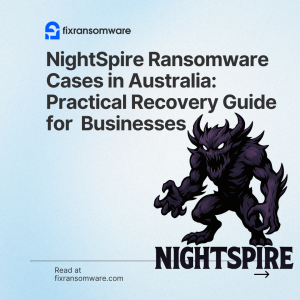When a small or medium business in Australia gets hit, the first Google search is often something like “NightSpire ransomware data recovery” or “NightSpire ransomware help”. By the time someone types that, the damage is usually done: file servers are locked, shared folders are unreadable, and staff can’t work. The good news: with the right approach, NightSpire ransomware data recovery is often possible without jumping straight to reinstalling everything or paying the ransom.
This guide is written for Australian SMEs that need a calm, realistic plan instead of panic.
What NightSpire Ransomware Does to Your Business
NightSpire is like most modern ransomware families: it quietly crawls through the network first, then detonates.
Typical impact includes:
- Encryption of shared folders, project files, and finance documents
- Databases for accounting, ERP, or CRM suddenly failing to open
- Backups on connected storage also being encrypted if they’re online 24/7
- Ransom notes demanding cryptocurrency and hinting at data leaks
For small and medium businesses in Australia, that can mean:
- Immediate loss of revenue because operations freeze
- Contract risk if you can’t deliver on time
- Possible legal and reputational issues if customer data was exposed
You can’t undo the initial breach, but you can absolutely control what happens next.
First Response: Contain the Damage Before You Talk About Payment
Any serious NightSpire ransomware data recovery effort starts with containment, not negotiation.
- Isolate suspected systems
- Disconnect infected servers, NAS devices, and PCs from the network.
- Temporarily disable VPN if remote users might be spreading the infection.
- Do not delete encrypted data
- Encrypted files generally no longer contain active malicious code.
- Those files are exactly what recovery specialists will need to work with.
- Identify how NightSpire is running
- Look for suspicious services, scheduled tasks, startup entries, and binaries.
- Kill processes that are clearly linked to encryption.
- Preserve evidence
- Keep ransom notes, firewall logs, EDR/AV alerts, and phishing emails.
- This is useful for internal review and possible reports to the FBI IC3 (for cross-border issues) or to Australian authorities following guidance similar to CISA StopRansomware.
Containment doesn’t fix everything, but it stops the fire from spreading and protects your recovery options.
NightSpire Ransomware Data Recovery: Assessing Your Position
Once things are stable enough, you can plan data recovery from NightSpire ransomware attacks more systematically:
- Map what’s actually affected
- List servers, NAS devices, and critical workstations that were hit.
- Separate “business-critical” from “annoying but survivable”.
- Evaluate backups honestly
- Do you have offline, off-site, or immutable backups that NightSpire couldn’t touch?
- Test a small restore in an isolated environment before relying on them.
- Confirm you’re dealing with NightSpire
- File extensions, note text, and attacker contact details usually reveal the family.
- Correct identification helps specialists pick safe techniques and avoid guesswork.
- Avoid random “all-in-one decryptors”
- Many tools online either don’t work or damage data structures.
- A bad attempt can turn a recoverable case into permanent loss.
Why Paying NightSpire’s Ransom Is a Dangerous Shortcut
Paying the ransom feels like a shortcut, but it’s a bet with terrible odds:
- There is no guarantee you get a working decryption key
- Decryption can fail or corrupt part of the data even with a key
- Your company may be marked as a paying target, inviting future attacks
- Legal and contractual problems remain, because the breach still happened
For most Australian SMEs, a structured NightSpire ransomware data recovery plan is a better investment than sending crypto into a black hole.
Working With a Professional Recovery Service
Small internal IT teams are often strong at daily ops but not at deep ransomware repair. That’s where a specialist helps:
- Start with sample analysis
- Provide a small set of encrypted files and, if possible, originals from backup.
- Specialists use these pairs to see if clean decryption or low-level repair is possible.
- Run test recovery in a lab
- All work begins on copies in an isolated environment, not on your only copy of production data.
- Only proven-safe methods are applied to full datasets.
- Restore in business priority order
- Accounting, ERP, and core file servers first; less critical systems later.
- Management gets realistic timelines, not “maybe tomorrow if we’re lucky”.
- Harden the environment before going live
- Patch exposed services, tighten remote access, close unused ports, and rotate credentials.
- Redesign backup with offline or immutable layers and regular restore tests.
FixRansomware focuses on complex server, NAS, and database cases, including NightSpire ransomware cases in Australia. You can securely upload small encrypted samples (under 1 MB) through app.fixransomware.com for initial analysis, and share larger data sets via cloud storage links when appropriate.
You can’t change the fact that NightSpire hit your business, but you can decide whether the next step is panic and payment or a controlled, professional recovery.


